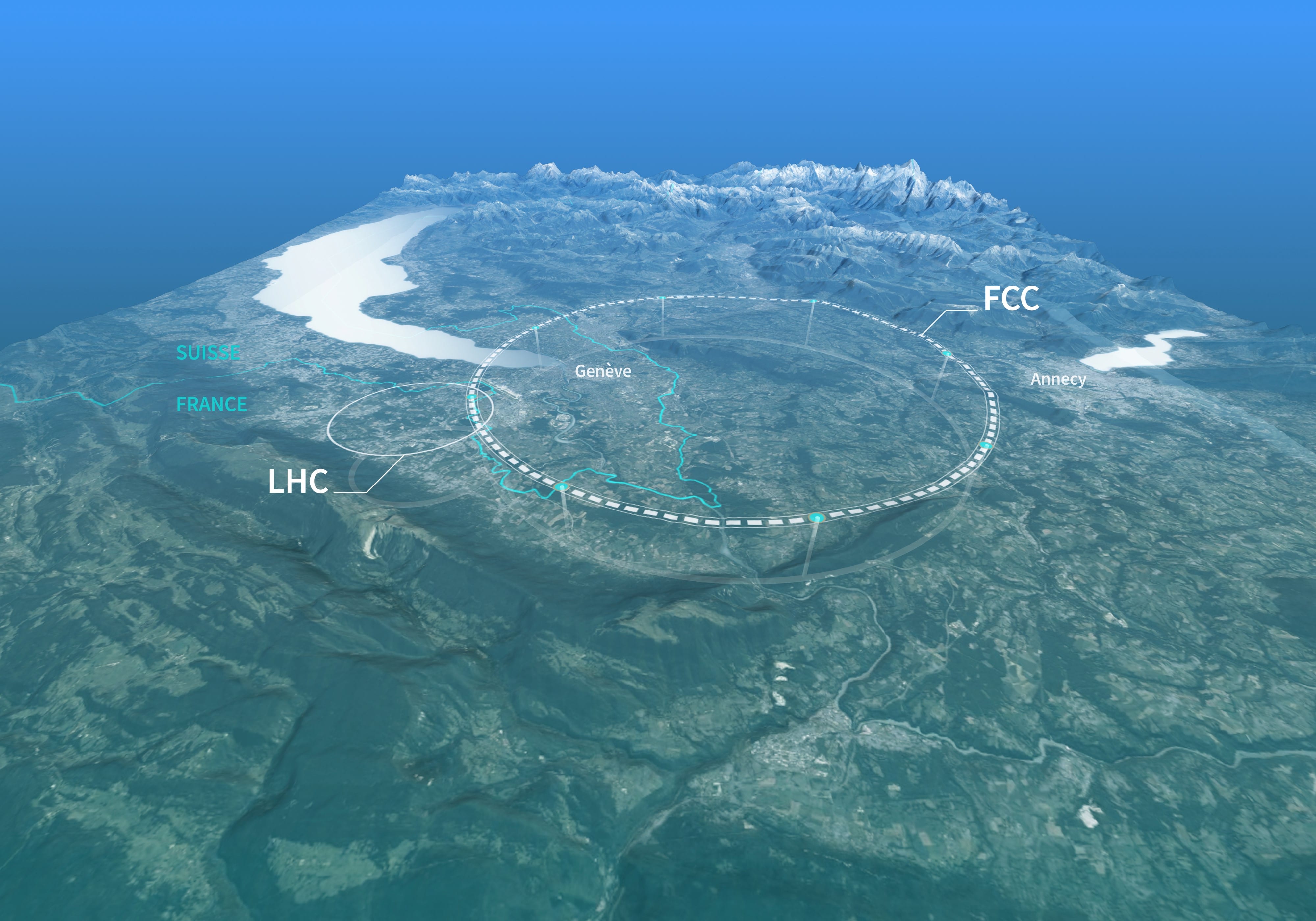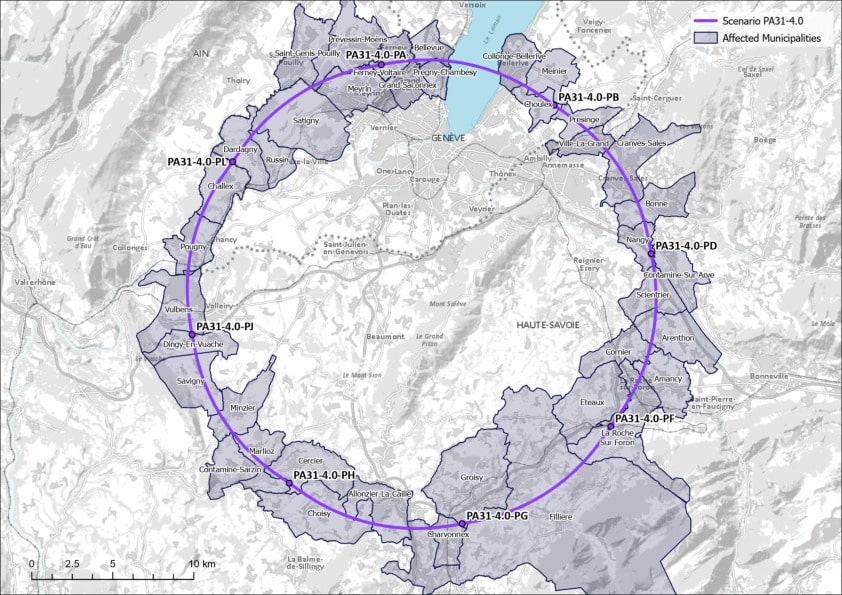What?
The Future Circular Collider (FCC) study is developing designs for higher performance particle colliders that could follow on from the Large Hadron Collider (LHC) once it reaches the end of its (High-Luminosity phase).
The ongoing FCC Feasibility Study, expected to conclude in 2025, is investigating the technical and financial viability of the FCC at CERN, including geological feasibility, environmental impact,
A new tunnel is planned with a circumference of 90.7 km, an average depth of 200 m and eight surface sites for up to four experiments. The tunnel would initially house the FCC-ee, an electron–positron collider for precision measurements offering a 15-year research programme from the mid-2040s. A second machine, the FCC-hh, would then be installed in the same tunnel, reusing the existing infrastructure, similar to when the LHC replaced LEP. The FCC-hh aims to reach collision energies of 100 TeV, colliding protons and also heavy-ions, and running until the end of the 21st century.
When?
The tentative timeline is:
- 2025: Completion of the FCC Feasibility Study
- 2027–2028: Decision by the CERN Member States and international partners
- 2030s:
Start of construction - Mid-2040s: FCC-ee begins operation and runs for approximately 15 years
- 2070s: FCC-hh begins operation and runs for approximately 25 years
Why?
Physics case
Solutions to these questions can be found in the vast landscape of possible physics scenarios lying beyond the Standard Model. Some scenarios suggest the existence of new, heavier particles, beyond the reach of the LHC, calling for higher-energy facilities. Others suggest the existence of lighter particles that interact very weakly with Standard Model particles and whose detection requires huge amounts of data to be collected and great sensitivity to the elusive signals of their production. By providing considerable advances in sensitivity and precision with the FCC-ee and, ultimately, energy far beyond the LHC with the FCC-hh, the FCC programme would allow physicists to explore this new landscape in full.
CERN has several options for future colliders, which are either circular or linear in shape. The lightness of the Higgs boson and the no-show so far of other new elementary particles at the LHC make circular e+e- colliders an appealing alternative to linear machines. They enable significantly higher luminosity and up to four experiments, while also offering the infrastructure for a subsequent hadron collider.
Read more: FCC: The Physics Case in the CERN Courier.
FCC IN A NUTSHELLTimeline
Tunnel
Two stages
Costs/benefits
|

Return on investment
Read more: Machine Matters in the CERN Courier.
How?
Civil engineering
Sustainability is a major focus of the FCC civil-engineering studies, as FCC construction activities would result in about 16.4 million tonnes of excavated materials over a period of five years.
|
Comparative construction projects |
Million tonnes of excavated material |
|
FCC |
16.4 |
|
Gotthard |
28.2 |
|
Grand Paris |
43 |
|
Lyon Turin |
37 |
|
HS2 Phase 1 |
130 |
|
Crossrail |
8 |
|
Stuttgart 21 |
40 |
To this end, the Mining the Future competition identified credible and innovative ways to reuse the molasse, including the use of limestone for concrete production and stabilisation of constructions within the project, the reuse of excavated materials to backfill quarries and mines, the transformation of sterile molasse into fertile soil for agriculture and forestry, the production of bricks from compressed molasse and the development of novel construction materials with molasse ingredients for use in the project where technically feasible.
The next step is to implement a pilot Open Sky Laboratory to demonstrate the separation techniques put forward by the winning consortium and collaborate with CERN’s Host States and other stakeholders to identify suitable locations for the use.
In addition, the FCC Feasibility Study is working to minimise the carbon footprint during construction and optimise transport systems between sites.
Water
The FCC-ee would be the largest particle accelerator ever built, with its radio frequency cavities and
The FCC-ee power consumption is expected to vary between 1 and 1.8 TWh/year depending on the machine’s operation mode. Thanks to ongoing R&D efforts, the power consumption of the FCC-ee is expected to be 30–40% lower than it would be if it were built using current technologies. The FCC study team is also working with regional authorities to identify ways in which part of this energy may be reused for heating in local industries and public infrastructures.
|
Comparative power consumption |
TWh/year |
|
FCC-ee |
Between 1 and 1.8 |
|
LHC |
1.3 |
|
High-Luminosity LHC |
1.6 |
|
Typical chemical production plant |
6 |
|
French electricity production |
510 |
Electrical power would be provided from the French electricity grid, and the system is designed so that no new sub-stations would need to be constructed for the different FCC-ee operation modes. Studies indicate that by the time the FCC comes into operation, a low carbon footprint can be achieved with an energy mix that contains a large fraction of energy from renewable sources.
Cost
Read more: Machine Matters and Tunnelling to the future in the CERN Courier.

Where?
Following eight years of study, one configuration was identified out of some 100 variants as being particularly suitable. This scenario envisages a tunnel with a circumference of about 90.7 km, eight surface sites with underground facilities at depths of between 180 and 400 metres and up to four experiments.
Where possible, the study has considered non-exploited land, with site perimeters kept to a strict minimum and surface needs reduced by more than 60% compared to the initial plans. The FCC would reuse existing sites such as the 3 ha LHC surface site in Ferney-Voltaire (for FCC PA) and the Prévessin surface site (for the FCC injector accelerator).
Read more: Where and How in the CERN Courier.
Who?
The global FCC collaboration spans more than 150 institutes in more than 30 countries, while new partners are still being sought to work on research and development.
Read more: The People Factor in the CERN Courier.
